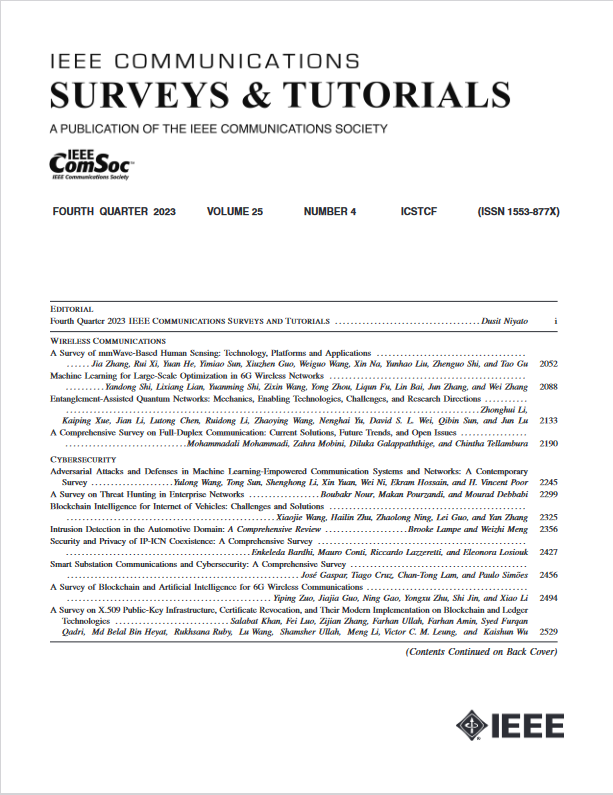DRX机制研究:从LTE和5G新无线电到6G通信系统的设备省电
IF 34.4
1区 计算机科学
Q1 COMPUTER SCIENCE, INFORMATION SYSTEMS
引用次数: 2
摘要
不连续接收(DRX)是用户设备(UE)节电最有效的基于定时器的机制。在长期演进(LTE)系统中,DRX机制的发展极大地延长了UE电池寿命。DRX机制允许终端进入休眠状态。给定一个DRX周期,UE需要在休眠期间定期唤醒,以检查是否收到新的下行数据包。该终端可以通过跳过大多数信道监控场合来实现高睡眠率。随着移动网络向5G演进,为了支持各种新业务,对电池寿命的要求也越来越高。第三代合作伙伴计划(3GPP)也增强了DRX机制,并在新无线电(NR)第16版标准中增加了新的DRX相关功能。除了基于时间的设计,3GPP还提出了两种基于信令的机制:省电信号和UE辅助信息。本文介绍了3GPP NR标准中最新的DRX机制,并总结了最新的研究进展。研究人员已经在各种用例中研究了DRX机制,例如Web浏览服务和异构网络。他们重点研究了UE睡眠率和数据包延迟,并提出了相应的分析模型。本文还讨论了新的DRX架构,以解决特定方案中的节能问题,特别是在5G NR网络中。本文根据目标业务和网络场景对论文进行了详细的分类和呈现。我们还对NR网络面临的新挑战(如波束形成和热问题)进行了综述,并介绍了6G时代未来的研究方向。本文章由计算机程序翻译,如有差异,请以英文原文为准。
A Survey on DRX Mechanism: Device Power Saving From LTE and 5G New Radio to 6G Communication Systems
The Discontinuous Reception (DRX) is the most effective timer-based mechanism for User Equipment (UE) power saving. In Long Term Evolution (LTE) systems, the development of the DRX mechanism enormously extends the UE battery life. With the DRX mechanism, a UE is allowed to enter a dormant state. Given a DRX cycle, the UE needs to wake up periodically during the dormancy to check whether it receives new downlink packets or not. The UE can achieve a high sleeping ratio by skipping most channel monitoring occasions. As the mobile network evolved to 5G, the battery life requirement increased to support various new services. 3rd Generation Partnership Project (3GPP) also enhances the DRX mechanism and adds new DRX-related features in the New Radio (NR) Release 16 standard. In addition to the time-based design, 3GPP proposed two signaling-based mechanisms: power saving signal and UE assistance information. This survey paper introduces the latest DRX mechanism in the 3GPP NR standard and summarizes the state-of-the-art research. Researchers have investigated the DRX mechanism in various use cases, such as Web browsing services and heterogeneous networks. They focus on the UE sleep ratio and packet delay and propose corresponding analytical models. New DRX architectures are also discussed to conquer the power-saving problem in specific schemes, especially in the 5G NR networks. This paper categorizes and presents the papers according to the target services and the network scenarios in detail. We also survey the work focusing on the new challenges (such as beamforming and thermal issue) in the NR network and introduce the future research directions in the 6G era.
求助全文
通过发布文献求助,成功后即可免费获取论文全文。
去求助
来源期刊

IEEE Communications Surveys and Tutorials
COMPUTER SCIENCE, INFORMATION SYSTEMS-TELECOMMUNICATIONS
CiteScore
80.20
自引率
2.50%
发文量
84
审稿时长
6 months
期刊介绍:
IEEE Communications Surveys & Tutorials is an online journal published by the IEEE Communications Society for tutorials and surveys covering all aspects of the communications field. Telecommunications technology is progressing at a rapid pace, and the IEEE Communications Society is committed to providing researchers and other professionals the information and tools to stay abreast. IEEE Communications Surveys and Tutorials focuses on integrating and adding understanding to the existing literature on communications, putting results in context. Whether searching for in-depth information about a familiar area or an introduction into a new area, IEEE Communications Surveys & Tutorials aims to be the premier source of peer-reviewed, comprehensive tutorials and surveys, and pointers to further sources. IEEE Communications Surveys & Tutorials publishes only articles exclusively written for IEEE Communications Surveys & Tutorials and go through a rigorous review process before their publication in the quarterly issues.
A tutorial article in the IEEE Communications Surveys & Tutorials should be designed to help the reader to become familiar with and learn something specific about a chosen topic. In contrast, the term survey, as applied here, is defined to mean a survey of the literature. A survey article in IEEE Communications Surveys & Tutorials should provide a comprehensive review of developments in a selected area, covering its development from its inception to its current state and beyond, and illustrating its development through liberal citations from the literature. Both tutorials and surveys should be tutorial in nature and should be written in a style comprehensible to readers outside the specialty of the article.
 求助内容:
求助内容: 应助结果提醒方式:
应助结果提醒方式:


